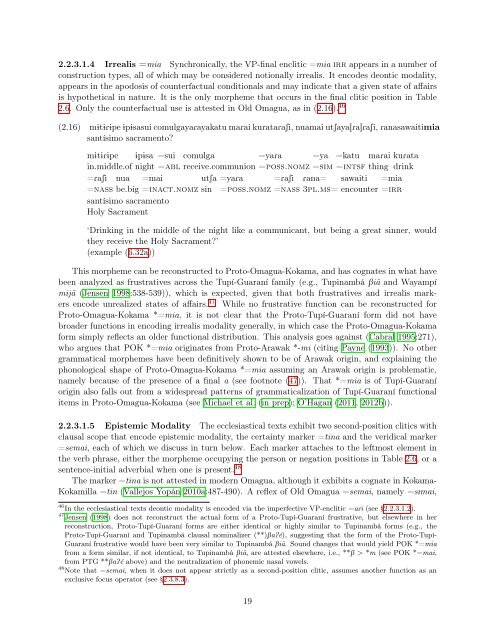draft manuscript - Linguistics - University of California, Berkeley
draft manuscript - Linguistics - University of California, Berkeley
draft manuscript - Linguistics - University of California, Berkeley
You also want an ePaper? Increase the reach of your titles
YUMPU automatically turns print PDFs into web optimized ePapers that Google loves.
2.2.3.1.4 Irrealis =mia Synchronically, the VP-final enclitic =mia irr appears in a number <strong>of</strong><br />
construction types, all <strong>of</strong> which may be considered notionally irrealis. It encodes deontic modality,<br />
appears in the apodosis <strong>of</strong> counterfactual conditionals and may indicate that a given state <strong>of</strong> affairs<br />
is hypothetical in nature. It is the only morpheme that occurs in the final clitic position in Table<br />
2.6. Only the counterfactual use is attested in Old Omagua, as in (2.16). 46<br />
(2.16) m1t1R1pe 1p1sasui comulgayaRayakatu maRai kuRataRaSi, nuamai utSaya[Ra]RaSi, Ranasawaitimia<br />
santísimo sacramento?<br />
m1t1R1pe 1p1sa =sui comulga =yaRa =ya =katu maRai kuRata<br />
in.middle.<strong>of</strong> night =abl receive.communion =poss.nomz =sim =intsf thing drink<br />
=RaSi nua =mai utSa =yaRa =RaSi Rana= sawaiti =mia<br />
=nass be.big =inact.nomz sin =poss.nomz =nass 3pl.ms= encounter =irr<br />
santísimo sacramento<br />
Holy Sacrament<br />
‘Drinking in the middle <strong>of</strong> the night like a communicant, but being a great sinner, would<br />
they receive the Holy Sacrament?’<br />
(example (6.32a))<br />
This morpheme can be reconstructed to Proto-Omagua-Kokama, and has cognates in what have<br />
been analyzed as frustratives across the Tupí-Guaraní family (e.g., Tupinambá Biã and Wayampí<br />
mijã (Jensen 1998:538-539)), which is expected, given that both frustratives and irrealis markers<br />
encode unrealized states <strong>of</strong> affairs. 47 While no frustrative function can be reconstructed for<br />
Proto-Omagua-Kokama *=mia, it is not clear that the Proto-Tupí-Guaraní form did not have<br />
broader functions in encoding irrealis modality generally, in which case the Proto-Omagua-Kokama<br />
form simply reflects an older functional distribution. This analysis goes against (Cabral 1995:271),<br />
who argues that POK *=mia originates from Proto-Arawak *-mi (citing Payne (1993)). No other<br />
grammatical morphemes have been definitively shown to be <strong>of</strong> Arawak origin, and explaining the<br />
phonological shape <strong>of</strong> Proto-Omagua-Kokama *=mia assuming an Arawak origin is problematic,<br />
namely because <strong>of</strong> the presence <strong>of</strong> a final a (see footnote (47)). That *=mia is <strong>of</strong> Tupí-Guaraní<br />
origin also falls out from a widespread patterns <strong>of</strong> grammaticalization <strong>of</strong> Tupí-Guaraní functional<br />
items in Proto-Omagua-Kokama (see Michael et al. (in prep); O’Hagan (2011, 2012b)).<br />
2.2.3.1.5 Epistemic Modality The ecclesiastical texts exhibit two second-position clitics with<br />
clausal scope that encode epistemic modality, the certainty marker =tina and the veridical marker<br />
=semai, each <strong>of</strong> which we discuss in turn below. Each marker attaches to the leftmost element in<br />
the verb phrase, either the morpheme occupying the person or negation positions in Table 2.6, or a<br />
sentence-initial adverbial when one is present. 48<br />
The marker =tina is not attested in modern Omagua, although it exhibits a cognate in Kokama-<br />
Kokamilla =tin (Vallejos Yopán 2010a:487-490). A reflex <strong>of</strong> Old Omagua =semai, namely =sImai,<br />
46 In the ecclesiastical texts deontic modality is encoded via the imperfective VP-enclitic =aRi (see §2.2.3.1.2).<br />
47 Jensen (1998) does not reconstruct the actual form <strong>of</strong> a Proto-Tupí-Guaraní frustrative, but elsewhere in her<br />
reconstruction, Proto-Tupí-Guaraní forms are either identical or highly similar to Tupinambá forms (e.g., the<br />
Proto-Tupí-Guaraní and Tupinambá clausal nominalizer (**)BaPé), suggesting that the form <strong>of</strong> the Proto-Tupí-<br />
Guaraní frustrative would have been very similar to Tupinambá Biã. Sound changes that would yield POK *=mia<br />
from a form similar, if not identical, to Tupinambá Biã, are attested elsewhere, i.e., **B > *m (see POK *=mai,<br />
from PTG **BaPé above) and the neutralization <strong>of</strong> phonemic nasal vowels.<br />
48 Note that =semai, when it does not appear strictly as a second-position clitic, assumes another function as an<br />
exclusive focus operator (see §2.3.8.3).<br />
19
















